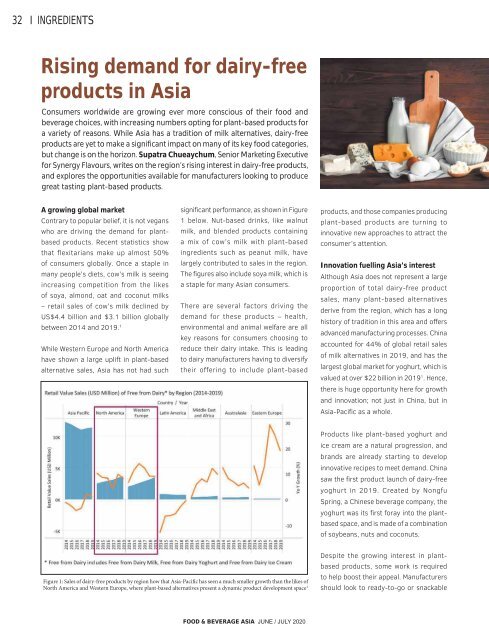Food & Beverage Asia June/July 2020
Food & Beverage Asia (FBA) is the leading source of food and beverage news in Asia since 2002. FBA delivers a comprehensive view of the food and beverage landscape, spanning across the latest health and nutrition trends and industry innovations in ingredients, recipe formulations, food science, sustainability, packaging, and automation, as well as advancements in agri and food-tech.
Food & Beverage Asia (FBA) is the leading source of food and beverage news in Asia since 2002. FBA delivers a comprehensive view of the food and beverage landscape, spanning across the latest health and nutrition trends and industry innovations in ingredients, recipe formulations, food science, sustainability, packaging, and automation, as well as advancements in agri and food-tech.
You also want an ePaper? Increase the reach of your titles
YUMPU automatically turns print PDFs into web optimized ePapers that Google loves.
32<br />
INGREDIENTS<br />
Rising demand for dairy-free<br />
products in <strong>Asia</strong><br />
Consumers worldwide are growing ever more conscious of their food and<br />
beverage choices, with increasing numbers opting for plant-based products for<br />
a variety of reasons. While <strong>Asia</strong> has a tradition of milk alternatives, dairy-free<br />
products are yet to make a significant impact on many of its key food categories,<br />
but change is on the horizon. Supatra Chueaychum, Senior Marketing Executive<br />
for Synergy Flavours, writes on the region’s rising interest in dairy-free products,<br />
and explores the opportunities available for manufacturers looking to produce<br />
great tasting plant-based products.<br />
A growing global market<br />
Contrary to popular belief, it is not vegans<br />
who are driving the demand for plantbased<br />
products. Recent statistics show<br />
that flexitarians make up almost 50%<br />
of consumers globally. Once a staple in<br />
many people’s diets, cow’s milk is seeing<br />
increasing competition from the likes<br />
of soya, almond, oat and coconut milks<br />
– retail sales of cow’s milk declined by<br />
US$4.4 billion and $3.1 billion globally<br />
between 2014 and 2019. 1<br />
While Western Europe and North America<br />
have shown a large uplift in plant-based<br />
alternative sales, <strong>Asia</strong> has not had such<br />
significant performance, as shown in Figure<br />
1 below. Nut-based drinks, like walnut<br />
milk, and blended products containing<br />
a mix of cow’s milk with plant-based<br />
ingredients such as peanut milk, have<br />
largely contributed to sales in the region.<br />
The figures also include soya milk, which is<br />
a staple for many <strong>Asia</strong>n consumers.<br />
There are several factors driving the<br />
demand for these products – health,<br />
environmental and animal welfare are all<br />
key reasons for consumers choosing to<br />
reduce their dairy intake. This is leading<br />
to dairy manufacturers having to diversify<br />
their offering to include plant-based<br />
products, and those companies producing<br />
plant-based products are turning to<br />
innovative new approaches to attract the<br />
consumer’s attention.<br />
Innovation fuelling <strong>Asia</strong>’s interest<br />
Although <strong>Asia</strong> does not represent a large<br />
proportion of total dairy-free product<br />
sales, many plant-based alternatives<br />
derive from the region, which has a long<br />
history of tradition in this area and offers<br />
advanced manufacturing processes. China<br />
accounted for 44% of global retail sales<br />
of milk alternatives in 2019, and has the<br />
largest global market for yoghurt, which is<br />
valued at over $22 billion in 2019 1 . Hence,<br />
there is huge opportunity here for growth<br />
and innovation; not just in China, but in<br />
<strong>Asia</strong>-Pacific as a whole.<br />
Products like plant-based yoghurt and<br />
ice cream are a natural progression, and<br />
brands are already starting to develop<br />
innovative recipes to meet demand. China<br />
saw the first product launch of dairy-free<br />
yoghurt in 2019. Created by Nongfu<br />
Spring, a Chinese beverage company, the<br />
yoghurt was its first foray into the plantbased<br />
space, and is made of a combination<br />
of soybeans, nuts and coconuts.<br />
Figure 1: Sales of dairy-free products by region how that <strong>Asia</strong>-Pacific has seen a much smaller growth than the likes of<br />
North America and Western Europe, where plant-based alternatives present a dynamic product development space 1<br />
Despite the growing interest in plantbased<br />
products, some work is required<br />
to help boost their appeal. Manufacturers<br />
should look to ready-to-go or snackable<br />
FOOD & BEVERAGE ASIA JUNE / JULY <strong>2020</strong>


















